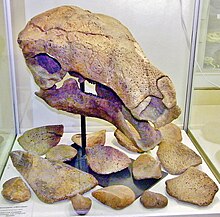Denversaurus
| Denversaurus | |
|---|---|

| |
| Skeleton cast of Denversaurus ("Tank"), Houston Museum of Natural Science | |
| Scientific classification | |
| Domain: | Eukaryota |
| Kingdom: | Animalia |
| Phylum: | Chordata |
| Clade: | Dinosauria |
| Clade: | †Ornithischia |
| Clade: | †Thyreophora |
| Clade: | †Ankylosauria |
| Family: | †Nodosauridae |
| Subfamily: | † Nodosaurinae
|
| Clade: | † Panoplosaurini
|
| Genus: | †Denversaurus Bakker, 1988 |
| Type species | |
| †Denversaurus schlessmani Bakker, 1988
| |
Denversaurus (meaning "Denver lizard") is a genus of
Discovery and naming

In 1922,
In 1988,
The fossil the species is based on, holotype specimen
Fossil hunters found a nodosaurid skeleton in Niobrara County, Wyoming, nicknamed "Tank", which has been identified as Denversaurus. The specimen contains the lower jaws, parts of the torso, and about a hundred osteoderms. It is part of the collection of the Rocky Mountain Dinosaur Resource Center under inventory number BHI 127327.[3]
The validity of Denversaurus was disputed in a 1990 paper on ankylosaurian systematics by Kenneth Carpenter, who noted that Bakker's diagnosis of Denversaurus was based primarily on Bakker's artistic restoration of the holotype in an uncrushed state. Since DMNH 468 was found crushed, Carpenter assigned Denversaurus to an Edmontonia sp., even though he noted its similarity to Edmontonia rugosidens.[4] A number of workers treated Denversaurus as synonymous with either E. rugosidens[5] or E. longiceps,[6] or alternatively as a valid species of Edmontonia: E. schlessmani.[7][8]
In an SVP 2015 abstract, Michael Burns revisited the systematics of latest Cretaceous nodosaurids from the Western Interior. According to Burns, Denversaurus is a valid taxon based on its
Description

In 2010, American paleontologist Gregory S. Paul estimated the length of Denversaurus at 6 metres (20 ft) and its body mass at 3 tonnes (3.3 short tons).[8]
Robert T. Bakker considered Denversaurus distinct from Edmontonia and Chassternbergia in having a skull that was wide at the rear and a more rearward position of the eye sockets.[2] The holotype skull has a length of 496 millimetres and a rear width of 346 millimetres. In the referred specimen AMNH 3076, these proportions are less extreme, measuring 395 millimetres long with a rear width of 220 millimetres. According to American paleontologist Kenneth Carpenter, the greater width of both the holotype and the referred specimen was due to crushing.[4]
In 2015, vertebrate anatomist and paleontologist Michael Burns published an abstract concluding that Denversaurus was different from Edmontonia, but similar to Panoplosaurus in having inflated, convex, cranial sculpturing with visible sulci, or troughs, between individual top skull armour elements, but is distinct from Panoplosaurus in having a relatively wider snout.[9]
Classification
In 1988, Bakker placed Denversaurus within
References
- ^ B. Brown and E.M. Schlaikjer, 1943, "A study of the troödont dinosaurs with the description of a new genus and four new species", Bulletin of the American Museum of Natural History 82(5): 115-150
- ^ a b c d e Bakker, R.T. (1988). "Review of the Late Cretaceous nodosauroid Dinosauria: Denversaurus schlessmani, a new armor-plated dinosaur from the Latest Cretaceous of South Dakota, the last survivor of the nodosaurians, with comments on Stegosaur-Nodosaur relationships". Hunteria 1(3): 1-23.(1988).
- ^ a b Carpenter, K. 1990. "Ankylosaur systematics: example using Panoplosaurus and Edmontonia (Ankylosauria: Nodosauridae)", In: Carpenter, K. & Currie, P.J. (eds) Dinosaur Systematics: Approaches and Perspectives, Cambridge University Press, Cambridge, pp. 281-298
- ^ W. P. Coombs and T. A. Deméré. 1996. A Late Cretaceous nodosaurid ankylosaur (Dinosauria: Ornithischia) from marine sediments of coastal California. Journal of Paleontology 70(2):311-326
- ^ M. K. Vickaryous, T. Maryanska, and D. B. Weishampel. 2004. Ankylosauria. In D. B. Weishampel, P. Dodson, and H. Osmolska (eds.), The Dinosauria (second edition). University of California Press, Berkeley 363-392
- ^ Hunt, A.P. and Lucas, S.G., 1992, "Stratigraphy, Paleontology and age of the Fruitland and Kirkland Formations (Upper Cretaceous), San Juan Basin, New Mexico", New Mexico Geological Society Guidebook, 43rd Field Conference, San Juan Basin, volume 4, p. 217-240
- ^ a b c Paul, G.S. (2010). The Princeton Field Guide to Dinosaurs, Princeton University Press.
- ^ a b c Burns, ME. Intraspecific Variation in Late Cretaceous Nodosaurids (Ankylosauria: Dinosauria). Journal of Vertebrate Paleontology, Program and Abstracts, 2015, 99–100.
